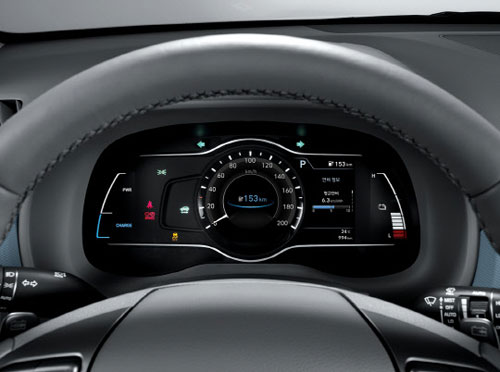Hyundai Mobis to apply digital cluster to Kona EV for the first time
Ye Jin Soo | jinye@ | 2018-05-10 10:23:09

A digital cluster of Hyundai Mobis applied to 'Kona EV' of Hyundai Motors. Photo by Hyundai Mobis
Hyundai Mobis, on May 9, revealed that it produced a digital cluster equipped with a 7-inch display and applied it to Hyundai`s Kona EV for the first time.
It began mass-producing a 7-inch cluster within three years after successfully developing a 12.3-inch large-scale cluster in 2015. The cluster is a key part of the cockpit (driver`s seat) that connects the driver and the car with the instrument cluster that displays driving information such as speed, mileage, and warning alarm. Hyundai Mobis has explained that it has been working on the development of the cluster for many years in order to secure the level 4 level autonomous driving competitiveness.
Meanwhile, the 7-inch digital cluster is based on AUTOSAR, the automotive software standard platform. It has a high resolution (1280x720) display to raise the visibility. An expert of the company stated, "We have developed our own central processing unit (CPU) software to enhance the degree of core technology independence."
Surround view monitoring (SVM), audio, video and navigation (AVN) with the mass production of this cluster, the company secured all of its proprietary technologies for four infotainment components, including head-up display (HUD). Yang Sung-wook, Vice President of Hyundai Mobis ICT Research Division, said, "We will advance ahead of the competition to develop the next-generation cockpit with global auto parts companies and information technology (IT) companies by developing an integrated platform capable of simultaneously controlling four major infotainment parts by 1H08" He stated. The company plans to develop a 12.3-inch dual-screen cluster and a 3D stereoscopic cluster in the future, and plans to mass-produce a 12.3-inch cluster by 2020.
On the other hand, Hyundai Mobis plans to cultivate digital clusters as a major overseas order item by actively conducting sales activities for domestic and overseas automakers.
The importance of clusters is now becoming more and more important as the number of driving and road traffic information provided to drivers through autonomous driving and connectivity activation goes up. It is rapidly being replaced by a digital cluster that can display a lot of information effectively from conventional analog methods. As a result, not only auto parts makers but also information technology firms are stepping into the digital cluster market. According to market researcher IHS Markit, the size of the digital cluster market is expected to increase from KRW 7,500 billion in 2016 to KRW 11 trillion in 2023. The firm has analyzed that digital clusters are expected to be applied to about 81% of new cars sold in 2023 (about KRW 9 trillion).
By Ye Jin Soo jinye@
